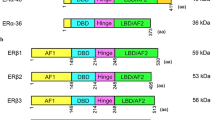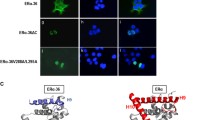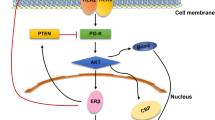Abstract
The most critical step for initiation and progression of estrogen receptor-α (ERα)-positive breast cancers is thought to be upregulation of ERα expression. There are several factors involved in this mechanism, i.e., increased promoter activity of the ERα gene (ESR1) at the transcriptional level, ESR1 gene amplification, and diminished degradation of ERα protein through ubiquitination and proteasomal pathways. Mediating these factors, ERα protein levels seem to be controlled, although the details of the mechanism remain to be clarified. In addition, for upregulation of estrogen signaling, functional changes in its action in cancer cells originating from normal epithelial cells, i.e., estrogen stimulation, which then leads to proliferation of ERα-positive cancer cells, has been recognized, but this action has not been observed in normal epithelial cells. These alterations are therefore likely to contribute to the pathogenesis of ERα-positive breast cancers.
Similar content being viewed by others
References
Henry JA, Nicholson S, Farndon JR, Westley BR, May FE (1988) Measurement of oestrogen receptor mRNA levels in human breast tumours. Br J Cancer 58:600–605
Green S, Walter P, Kumar V, Krust A, Bornert JM, Argos P, Chambon P (1986) Human oestrogen receptor cDNA: sequence, expression and homology to v-erb-A. Nature (Lond) 320:134–139
deGraffenried LA, Hilsenbeck SG, Fuqua SA (2002) Sp1 is essential for estrogen receptor alpha gene transcription. J Steroid Biochem Mol Biol 82:7–18
Hayashi S, Imai K, Suga K, Kurihara T, Higashi Y, Nakachi K (1997) Two promoters in expression of estrogen receptor messenger RNA in human breast cancer. Carcinogenesis (Oxf) 18:459–464
Holst F, Stahl PR, Ruiz C, Hellwinkel O, Jehan Z, Wendland M, Lebeau A, Terracciano L, Al-Kuraya K, Jänicke F, Sauter G, Simon R (2007) Estrogen receptor alpha (ESR1) gene amplification is frequent in breast cancer. Nat Genet 39:655–660
Brown LA, Hoog J, Chin SF, Tao Y, Zayed AA, Chin K, Teschendorff AE, Quackenbush JF, Marioni JC, Leung S, Perou CM, Neilsen TO, Ellis M, Gray JW, Bernard PS, Huntsman DG, Caldas C (2008) ESR1 gene amplification in breast cancer: a common phenomenon? Nat Genet 40:806–807
Martin MB, Saceda M, Lindsey RK (1993) Regulation of estrogen receptor expression in breast cancer. Adv Exp Med Biol 330:143–153
Lonard DM, Nawaz Z, Smith CL, O’Malley BW (2000) The 26S proteasome is required for estrogen receptor-alpha and coactivator turnover and for efficient estrogen receptor-alpha transactivation. Mol Cell 5:939–948
Molinari E, Gilman M, Natesan S (1999) Proteasome-mediated degradation of transcriptional activators correlates with activation domain potency in vivo. EMBO J 18:6439–6447
Duong V, Boulle N, Daujat S, Chauvet J, Bonnet S, Neel H, Cavaillès V (2007) Differential regulation of estrogen receptor alpha turnover and transactivation by Mdm2 and stress-inducing agents. Cancer Res 67:5513–5521
Li L, Li Z, Howley PM, Sacks DB (2006) E6AP and calmodulin reciprocally regulate estrogen receptor stability. J Biol Chem 281:1978–1985
Eakin CM, Maccoss MJ, Finney GL, Klevit RE (2007) Estrogen receptor alpha is a putative substrate for the BRCA1 ubiquitin ligase. Proc Natl Acad Sci U S A 104:5794–5799
Fan M, Nakshatri H, Nephew KP (2004) Inhibiting proteasomal proteolysis sustains estrogen receptor-alpha activation. Mol Endocrinol 18:2603–2615
Grisouard J, Medunjanin S, Hermani A, Shukla A, Mayer D (2007) Glycogen synthase kinase-3 protects estrogen receptor alpha from proteasomal degradation and is required for full transcriptional activity of the receptor. Mol Endocrinol 21:2427–2439
Hayashi S, Yamaguchi Y (2008) Estrogen signaling pathway and hormonal therapy. Breast Cancer 15:256–261
Sisci D, Surmacz E (2007) Crosstalk between IGF signaling and steroid hormone receptors in breast cancer. Curr Pharm Des 13:705–717
Weigel NL, Zhang Y (1998) Ligand-independent activation of steroid hormone receptors. J Mol Med 76:469–479
Clarke RB, Howell A, Potten CS, Anderson E (1997) Dissociation between steroid receptor expression and cell proliferation in the human breast. Cancer Res 57:4987–4991
Tan H, Zhong Y, Pan Z (2009) Autocrine regulation of cell proliferation by estrogen receptor-alpha in estrogen receptor-alphapositive breast cancer cell lines. BMC Cancer 26:31
Fabian CJ, Kimler BF, Zalles CM, Khan QJ, Mayo MS, Phillips TA, Simonsen M, Metheny T, Petroff BK (2007) Reduction in proliferation with six months of letrozole in women on hormone replacement therapy. Breast Cancer Res Treat 106:75–84
Ewan KB, Oketch-Rabah HA, Ravani SA, Shyamala G, Moses HL, Barcellos-Hoff MH (2005) Proliferation of estrogen receptoralphapositive mammary epithelial cells is restrained by transforming growth factor-beta-1 in adult mice. Am J Pathol 167:409–417
Badve S, Nakshatri H (2009) Oestrogen-receptor-positive breast cancer: towards bridging histopathological and molecular classifications. J Clin Pathol 62:6–12
Harrell JC, Dye WW, Harvell DM, Pinto M, Jedlicka P, Sartorius CA, Horwitz KB (2007) Estrogen insensitivity in a model of estrogen receptor positive breast cancer lymph node metastasis. Cancer Res 67:10582–10591
Author information
Authors and Affiliations
Corresponding author
Additional information
The content of this article has been presented at the 41st annual meeting of the Japanese Society for Clinical Molecular Morphology
Rights and permissions
About this article
Cite this article
Miyoshi, Y., Murase, K., Saito, M. et al. Mechanisms of estrogen receptor-α upregulation in breast cancers. Med Mol Morphol 43, 193–196 (2010). https://doi.org/10.1007/s00795-010-0514-3
Received:
Accepted:
Published:
Issue Date:
DOI: https://doi.org/10.1007/s00795-010-0514-3




